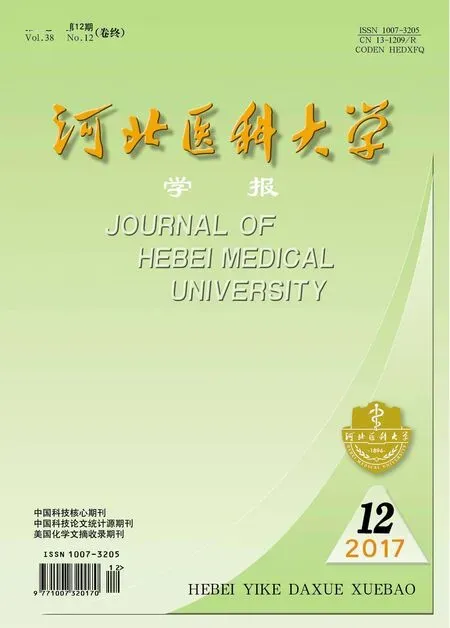不同胎龄新生儿血清N端C型利钠尿肽前体和成骨标志物表达及意义
2017-12-23皮亚雷张亚男张会丰
皮亚雷,张亚男,张会丰,阎 雪
(河北医科大学第二医院儿科,河北 石家庄 050000)
·论著·
不同胎龄新生儿血清N端C型利钠尿肽前体和成骨标志物表达及意义
皮亚雷,张亚男,张会丰,阎 雪*
(河北医科大学第二医院儿科,河北 石家庄 050000)
目的探讨血清N端C型利钠尿肽前体(amino-terminal pro-C-type natriuretic peptide,NT-proCNP)、骨碱性磷酸酶(bone specific alkaline phosphatase,BAP)、骨钙蛋白(osteocalcin,OC)在不同胎龄新生儿成骨中的作用及意义。方法选择生后24 h内新生儿80例,按胎龄分为A组(胎龄<32周)、B组(32周≤胎龄<37周)、C组(37周≤胎龄<42周);按出生身长百分位数分为身长小于胎龄儿组(小于同胎龄儿第10百分位数,L1组)、身长适于胎龄儿组(位于同胎龄儿10~90百分位数,L2组)、身长大于胎龄儿组(大于同胎龄儿第90百分位数,L3组);按体质量百分位数分为体质量小于胎龄儿组(小于同胎龄儿第10百分位数,W1组)、体质量适于胎龄儿组(位于同胎龄儿10~90百分位数,W2组)、体质量大于胎龄儿组(大于同胎龄儿第90百分位数,W3组)。生后1 h内测量出生身长、体质量,24 h内测定血清NT-proCNP、BAP及OC等指标。结果男性和女性新生儿胎龄、出生身长、体质量、NT-proCNP、BAP及OC差异均无统计学意义(P>0.05);B、C组出生身长、体质量高于A组,C组出生身长、体质量高于B组,C组BAP低于A、B组(P<0.05);3组性别、NT-proCNP、OC差异均无统计学意义(P>0.05);L3组BAP水平低于L1组和L2组(P<0.05),3组间NT-proCNP及OC水平差异均无统计学意义(P>0.05);W1、W2、W3组NT-proCNP、BAP及OC水平差异均无统计学意义(P>0.05)。新生儿出生体质量及身长均与胎龄呈正相关(P<0.05),NT-proCNP及OC与胎龄、出生体质量、身长及BAP无相关性(P>0.05);BAP与胎龄、体质量、身长呈负相关(P<0.05)。结论未发现血清NT-proCNP水平与妊娠中晚期胎儿骨生长发育的内在联系。BAP与胎儿骨骼生长发育密切相关,随着胎龄增加,胎儿成骨逐渐减弱。胎儿期骨矿化作用弱,新生儿骨强度小,可能有利于分娩。
骨发育;利钠肽,C型;成骨标志物;婴儿,新生
10.3969/j.issn.1007-3205.2017.12.013
研究表明,C型钠尿肽(C-type natriuretic peptide,CNP)在软骨内成骨中起着重要作用[1]。CNP血清、血浆及全血浓度之间差距大,N端C型利钠尿肽前体(amino-terminal pro-C-type natriuretic peptide,NT-proCNP)血清、血浆及全血浓度无明显差别,更稳定可靠[2],且与CNP等摩尔产生,故常用NT-proCNP间接反映CNP的合成。研究显示,NT-proCNP与5~18岁儿童身高增长速度呈正相关,是反映生后生长过程中软骨细胞活性的潜在标志物[3]。NT-proCNP在不同胎龄新生儿血清中的表达及其与成骨细胞标志物的关系值得探讨。本研究通过测定不同胎龄新生儿血清中NT-proCNP、 骨碱性磷酸酶(bone specific alkaline phosphatase,BAP)、骨钙蛋白(osteocalcin,OC)水平,探讨新生儿NT-proCNP水平及其与成骨细胞标志物的关系,以期了解NT-proCNP在新生儿软骨内成骨中的作用。
1 资 料 与 方 法
1.1一般资料 选择2016年11 月—2017 年 4月我院儿科生后24 h内的新生儿80例,男性51例,女性29例。按胎龄分为A组19例[胎龄<32周,胎龄范围26.6~31.9周,中位数30.4(28.3,31.4)周],B组35例[32周≤胎龄<37周,胎龄范围32.1~36.9周,中位数34.30(33.60,35.10)周],C组26例[37周≤胎龄<42周,胎龄范围37.3~41.7周,中位数39.9(37.98,40.63)周];按出生身长分为身长小于胎龄儿组17例(L1组,出生身长小于同胎龄儿第10百分位数)、身长适于胎龄儿组47例(L2组,出生身长10~90百分位数)及身长大于胎龄儿组16例(L3组,出生身长大于第90百分位数);按体质量分为体质量小于胎龄儿组23例(W1组,体质量小于同胎龄儿第10百分位数)、体质量适于胎龄儿组47例(W2组,体质量10~90百分位数)及体质量大于胎龄儿组10例(W3组,体质量大于第90百分位数)。所有新生儿均无严重缺氧、感染,无心力衰竭及肝肾功能异常,母亲无代谢性骨病、心力衰竭,无营养受限等。
本研究经医院伦理委员会批准,所有新生儿家长均知情同意并签署知情同意书。
1.2样本采集及检测 入选新生儿均于出生即刻测量身长、体质量,24 h内开奶前采集上肢静脉血2 mL,不抗凝,待血液充分凝固后,3 000 r/min离心5 min,分别留取血清,置-20 ℃冰箱保存待测。采用酶联免疫吸附测定法检测血清NT-proCNP(BIOMEDICA,奥地利)、BAP(MetraTM,美国)、OC(DSL,美国)水平。应用全自动酶标仪(Wellscan MK3,芬兰)、全自动洗板机(DEM-Ⅱ,北京)。
1.3统计学方法 应用SPSS 21.0统计学软件分析数据。正态分布的计量资料比较分别采用成组设计的t检验、F检验和LSD检验;非正态分布的计量资料以中位数(M)和四分位数(Q1,Q3)表示,比较采用秩和检验。计数资料比较采用χ2检验。相关性采用Pearson相关分析。P<0.05为差异有统计学意义。
2 结 果
2.1不同性别新生儿测定指标比较 男性和女性新生儿胎龄、出生身长、体质量、NT-proCNP、BAP及OC差异均无统计学意义(P>0.05),见表1。

表1 不同性别新生儿测定指标比较Table 1 Comparison of neonatal indexes between different genders
2.2不同胎龄组新生儿测定指标比较 B、C组出生身长、体质量高于A组,C组出生身长、体质量高于B组,C组BAP低于A、B组,差异均有统计学意义(P<0.05);3组性别、NT-proCNP、OC差异均无统计学意义(P>0.05)。见表2。

表2 不同胎龄新生儿测定指标比较Table 2 Comparison of neonatal indexes in different gestational age
*P<0.05与A组比较 #P<0.05与B组比较(秩和检验或LSD检验)
2.3身长适于胎龄组测定指标比较 L3组BAP水平低于L1组和L2组,差异均有统计学意义(P<0.05);3组间NT-proCNP及OC水平差异均无统计学意义(P>0.05)。见表3。

表3 身长适于胎龄组测定指标比较Table 3 Comparison of indexes in body length appropriate for gestational age groups
*P<0.05与L1组比较 #P<0.05与L2比较(秩和检验或LSD检验)
2.4体质量适于胎龄组测定指标比较 3组NT-proCNP、BAP及OC水平差异均无统计学意义(P>0.05),见表4。
2.5相关性分析 新生儿出生体质量及身长均与胎龄呈正相关(r=0.767、0.747,P<0.05);NT-proCNP及OC与胎龄、出生体质量、身长及BAP无相关性(r=-0.026、0.151、-0.047、0.148,r=0.026、0.004、0.087、0.199,P>0.05);BAP与胎龄、体质量、身长呈负相关(r=-0.306、-0.230、-0.309,P<0.05)。

表4 体质量适于胎龄组测定指标比较Table 4 Comparison of indexes in body weight appropriate for gestational age groups
3 讨 论
胎儿期及新生儿期为人一生中生长速度最快的时期,骨骼生长发育是胎儿及新生儿纵向生长的基础,骨骺软骨内成骨为长骨纵向生长的中心环节。软骨内成骨过程受一系列内分泌、自分泌和旁分泌因子的调控,是一个复杂、精细及完整、严密的网络系统。CNP通过促进软骨细胞增殖、肥大、基质分泌调节生长板生长[4],是小鼠生长板生长重要的正向旁分泌调节因子[5]。CNP通过与靶细胞表面受体NPR-B结合发挥作用。在人类,CNP基因NPPC突变可引起常染色体显性遗传性矮小[6],NPR-B基因Npr2功能失活性突变是发生Maroteaux型肢端肢中发育不良的病因[7],此类患者家族中Npr2功能失活性突变携带者身高标准差得分均较非携带者及正常人群显著降低[8],而Npr2功能获得性突变引起过度生长[9-11]。表明CNP-NPR-B通路在人类软骨内成骨中亦起着重要作用。
目前国内外学者多数研究主要关注生后及年长儿CNP表达情况[12-14],有关胎儿及新生儿CNP表达的研究甚少。因此,本研究选择不同胎龄新生儿(胎龄26.2~41.7周)为研究对象,探讨CNP在新生儿及妊娠中晚期软骨内成骨中的作用。由于CNP很快被清除性受体NPR-C及中性肽链内切酶清除,血清、血浆及全血浓度波动大,而NT-proCNP更稳定可靠,易于检测[2],且与CNP等摩尔产生,故本研究通过测定NT-proCNP间接反映CNP的合成。
本研究结果显示,不同性别间新生儿胎龄、出生身长、体质量、NT-proCNP、BAP及OC差异均无统计学意义;不同胎龄组间NT-proCNP差异无统计学意义;身长小于、适于、大于胎龄儿3组间及体质量小于、适于、大于胎龄儿3组间NT-proCNP差异亦无统计学意义;NT-proCNP与胎龄、出生身长、BAP、OC均无明显相关性。与国外学者研究结果不同[15]。推测可能原因为:与国外研究比较,虽然均将肝肾功能异常、骨代谢疾病、心力衰竭等已知影响CNP因素剔除,但国外学者纳入新生儿疾病谱更广泛,包括外科性疾病、严重感染、部分受试新生儿胃肠道喂养受限等,众多混杂因素可能影响血清NT-proCNP结果[16-18]。通过选择无营养受限孕母及新生儿生后24 h内尽早采血,可避免营养等因素的干扰。另外,CNP主要参与长骨生长,胎儿及新生儿头部扁骨所占比例大,可能影响NT-proCNP与身长的相关性。动物实验中小鼠CNP基因靶向断裂模型研究及人类Npr2基因功能失活/获得性突变[19]均显示,受累个体出生身长与正常个体无差别,生后随时间推移,生长受限或过度生长逐渐显著。因此,结合本研究的发现,推测CNP-NPR-B信号通路可能并非宫内骨生长的关键因子,只在生后骨纵向生长中发挥重要作用。尽管本研究中NT-proCNP未显示性别差异,且与胎龄无明显相关性,与Prickett等[15]研究不一致,但Prickett等还进行了纵向研究及NT-proCNP与下肢生长速度的相关性研究,显示NT-proCNP与生后下肢生长速度呈正相关。一方面提示NT-proCNP在生后长骨生长中起着重要作用,另一方面提示应增加纵向研究,以进一步探讨NT-proCNP在长骨生长中的作用。
成骨细胞在骨形成阶段生成大量BAP,BAP是反映机体成骨细胞功能的特异性分子标志物,也是成骨细胞外基质成熟的标志物,细胞外基质开始矿化后,BAP活性即减低。本研究结果显示,C组BAP低于A、B组(P<0.05),且BAP与胎龄、出生身长、体质量呈负相关。提示BAP与宫内胎儿骨生长有关,胎龄越小,成骨细胞活性越强,随着胎龄增加,成骨细胞活性减弱,这与妊娠中晚期胎儿胫骨生长速度逐渐减慢趋势是一致的。OC在成骨细胞外基质矿化阶段表达,促进钙磷盐向羟磷灰石转变,最终增加骨盐含量,提高骨强度。OC在生后3个月内显著升高。本研究结果显示,A、B、C 3组OC水平差异无统计学意义,与胎龄、出生体质量、身长、BAP、NT-proCNP均无相关性。可能与胎儿各期骨矿化作用均弱、新生儿骨强度小、有利于分娩有关。
综上所述,本研究未发现血清NT-proCNP水平与妊娠中晚期胎儿骨生长发育的内在联系,CNP-NPR-B信号通路可能并非胎儿宫内骨生长关键因子,只在生后骨纵向生长中发挥重要作用,今后需要更多纵向研究以进一步阐释NT-proCNP在长骨生长中的作用;BAP与妊娠中晚期胎儿骨骼生长发育密切相关;胎儿期骨矿化作用弱,新生儿骨强度小,可能利于分娩。
[1] Amano N,Mukai T,Ito Y,et al. Identification and functional characterization of two novel NPR2 mutations in Japanese patients with short stature[J]. J Clin Endocrinol Metab,2014,99(4):E713-718.
[2] Kuehnl A,Pelisek J,Bruckmeier M,et al. Comparative measurement of CNP and NT-proCNP in human blood samples:a methodologicalevaluation[J]. J Negat Results Biomed,2013,12:7.
[3] Olney RC,Salehi P,Prickett TC,et al. Dynamic response of C-type natriuretic peptide and its aminoterminal propeptide(NTproCNP) to growth hormone treatment in children with short stature[J]. Clin Endocrinol(Oxf),2016,85(4):561-568.
[4] Peake NJ,Hobbs AJ,Pingguan-Murphy B,et al. Role of C-type natriuretic peptide signalling in maintaining cartilage and bone function[J]. Osteoarthritis Cartilage,2014,22(11):1800-1807.
[5] Nakao K,Osawa K,Yasoda A,et al. The Local CNP/GC-B system in growth plate is responsible for physiological endochondral bone growth[J]. Sci Rep,2015,5:10554.
[6] Hisado-Oliva A,Ruzafa-Martin A,Sentchordi L,et al. Mutations in C-natriuretic peptide(NPPC):a novel cause of autosomal dominant short stature[J]. Genet Med,2017[Epub ahead of print].
[7] Wang W,Song MH,Miura K,et al. Acromesomelic dysplasia,type maroteaux caused by novel loss-of-function mutations of the NPR2 gene:Three case reports [J]. Am J Med Genet A,2016,170A(2):426-434.
[8] Wang SR,Jacobsen CM,Carmichael H,et al. Heterozygous mutations in natriuretic peptide receptor-B(NPR2) gene as a cause of short stature[J]. Hum Mutat,2015,36(4):474-481.
[9] Dickey DM,Otto NM,Potter LR. Skeletal overgrowth-causing mutations mimic an allosterically activated conformation of guanylyl cyclase-B that is inhibited by 2,4,6,-trinitrophenyl ATP[J]. J Biol Chem,2017,292(24):10220-10229.
[10] Vasques GA,Arnhold IJ,Jorge AA. Role of the natriuretic peptide system in normal growth and growth disorders[J]. Horm Res Paediatr,2014,82(4):222-229.
[11] Hannema SE,van Duyvenvoorde HA,Premsler T,et al. An activating mutation in the kinase homology domain of the natriuretic peptide receptor-2 causes extremely tall stature without skeletal deformities[J]. J Clin Endocrinol Metab,2013,98(12):E1988-1998.
[12] Kubota T,Wang W,Miura K,et al. Serum NT-proCNP levels increased after initiation of GH treatment in patients with achondroplasia/hypochondroplasia[J]. Clin Endocrinol(Oxf),2016,84(6):845-850.
[13] Topcu S,Özhan B,Alkan A,et al. A comparative analysis of plasma amino-terminal propeptide of C-type natriuretic peptide(NT-proCNP) concentration in children with normal-weight versus obesity during growth[J]. J Clin Res Pediatr Endocrinol,2017[Epub ahead of print].
[14] Olney RC,Prickett TC,Espiner EA,et al. C-type natriuretic peptide plasma levels are elevated in subjects with achondroplasia,hypochondroplasia,and thanatophoric dysplasia[J]. J Clin Endocrinol Metab,2015,100(2):E355-359.
[15] Prickett TC,Dixon B,Frampton C,et al. Plasma amino-terminal pro C-type natriuretic peptide in the neonate:relation to gestational age and postnatal linear growth[J]. J Clin Endocrinol Metab,2008,93(1):225-232.
[16] Prickett TC,Rumball CW,Buckley AJ,et al. C-Type natriuretic peptide forms in the ovine fetal and maternal circulations:evidence for independent regulation and reciprocal response to undernutrition[J]. Endocrinology,2007,148(8):4015-4022.
[17] Tomasiuk R,Mikaszewska-Sokolewicz M,Szlufik S,et al. The prognostic value of concomitant assessment of NT-proCNP,C-reactive protein,procalcitonin and inflammatory cytokines in septic patients[J]. Crit Care,2014,18(3):440.
[18] Prickett TC,Doughty RN,Troughton RW,et al. C-Type natriuretic peptides in coronary disease[J]. Clin Chem,2017,63(1):316-324.
[19] Miura K,Kim VH,Lee HR,et al. Overgrowth syndrome associated with a gain-of-function mutation of the natriuretic peptide receptor 2(NPR2) gene[J]. Am J Med Genet A,2014,164A(1):156-163.
Theexpressionandsignificanceofamino-terminalpropeptideofC-typenatriureticpeptideandboneformationmarkersforneonatesofdifferentgestationalage
PI Ya-lei, ZHANG Ya-nan, ZHANG Hui-feng, YAN Xue*
(DepartmentofPediatrics,theSecondHospitalofHebeiMedicalUniversity,Shijiazhuang050000,China)
ObjectiveTo investigate the role and significance of amino-terminal pro-C-type natriuretic peptide(NT-proCNP), bone specific alkaline(BAP) and osteocalcin(OC) in bone-formation of neonates with different gestational age.MethodsEighty cases of neonates born within 24 hours were selected and were divided into group A(gestational age<32 weeks), group B(32 weeks ≤gestational age<37 weeks), and group C(37 weeks ≤ gestational age<42 weeks) according to gestational age. According to the body length participants were divided into three groups: length less than that of gestational age group(L1 group), length appropriate for gestational age group(L2 group), and length greater than the gestational age group(L3 group). According to body weight percentile, they were divided into three groups: body weight less than that of gestational age group(W1 group), body weight appropriate for gestational age group(W2 group), and body weight greater than gestational age group(W3 group). Birth length and body mass were measured within 1 hour after birth. Serum NT-proCNP, BAP and OC were measured within 24 hours after birth.ResultsThere were no significant differences in gestational age, birth length, body mass, NT-proCNP, BAP and OC between male and female neonates(P>0.05). Participants from group B and C had higher birth length and body weight than A group. Participants from group C had higher birth length and body weight than group B. BAP of group C was lower than that of group A and B(P<0.05). There was no significant difference in gender, NT-proCNP and OC among 3 groups(P>0.05). BAP of group L3 was lower than that of group L1 and L2(P<0.05). There was no significant difference in the levels of NT-proCNP and OC among 3 groups(P>0.05); NT-proCNP, BAP and OC level had no significant difference among group W1, W2 and W3(P>0.05). Neonatal birth weight and body length were positively correlated with gestational age(P<0.05). There were no correlation between NT-proCNP and OC and gestational age, birth weight and BAP(P>0.05). BAP and gestational age, body weight, and body length were negatively correlated(P<0.05).ConclusionNo relationship between serum NT-proCNP levels and fetal bone development during the second and third trimester of pregnancy was found. BAP is closely correlated with fetal bone growth and development. With the increase of gestational age, fetal ossification gradually weakened. The mineralization of fetal bone is weak and the bone strength of newborn is samll, which may be beneficial to delivery.
bone development; natriuretic peptide, C-type; osteogenic markers; infant, newborn
2017-09-05;
2017-09-26
皮亚雷(1982-),女,河北行唐人,河北医科大学第二医院主治医师,医学硕士,从事儿童内分泌遗传代谢疾病诊治研究。
*通讯作者。E-mail:ywcyx752@163.com
R336
A
1007-3205(2017)12-1413-05
赵丽洁)
